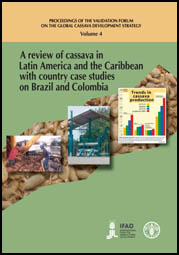
PROCEEDINGS OF THE VALIDATION FORUM ON THE GLOBAL CASSAVA DEVELOPMENT STRATEGY
Volume 4
A Review of Cassava in Latin America and the Caribbean with Country Case Studies on Brazil and Colombia
FOOD AND AGRICULTURE ORGANIZATION OF THE UNITED NATIONS
Rome, 2004